Tag: Visual edit |
No edit summary Tag: Visual edit |
||
| Line 13: | Line 13: | ||
| race = [[Ainur]] ([[Maiar]]) |
| race = [[Ainur]] ([[Maiar]]) |
||
| culture = [[Istari]] ([[Wizards]])<br/>Maiar of [[Yavanna]] |
| culture = [[Istari]] ([[Wizards]])<br/>Maiar of [[Yavanna]] |
||
| − | | gender = |
+ | | gender =Male |
| − | | height = |
+ | | height =1.96 m |
| − | | hair = |
+ | | hair =Brown (going grey) |
| − | | eyes = |
+ | | eyes =Hazel |
| actor = [[Sylvester McCoy]] (The Hobbit trilogy) |
| actor = [[Sylvester McCoy]] (The Hobbit trilogy) |
||
| voice = |
| voice = |
||
Revision as of 16:31, 12 November 2019
Radagast (Adûnaic; IPA: ['radagast] - "Tender Of Beasts") the Brown, also called Aiwendil (Quenya; IPA: [ai'wendil] - "Bird-Friend") was one of the Wizards, or Istari, sent to Middle-earth to contest the will of Sauron. Originally a Maia of Yavanna, Radagast was mainly concerned with the well-being of the plant and animal worlds, and thus did not participate heavily in the War of the Ring.
Biography
Years of the Lamps
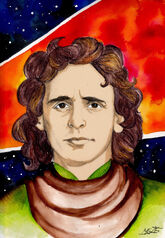
Radagast was a Maia named Aiwendil before leaving the Undying Lands
Originally called Aiwendil, he was a Maia created from before Time who descended to Arda in order to serve the Valar.[1] Aiwendil was a servant of the Valië Yavanna, the Queen of earth.
After the Undying Lands were separated from Arda during the Downfall of Númenor, Manwë was still concerned for the fate of the peoples of Middle-earth, because despite Sauron was overthrown, it would later turn out that he had not been effectively vanquished and his shadow began to fall a second time. A council of the Valar was summoned and it was decided that they would send emissaries to Middle-earth, these should be "mighty peers of Sauron, yet forgo might, and clothe themselves in flesh," as they were intended to help Men and Elves unite against Sauron, but the wizards were forbidden from matching the Dark Lord in power and fear.. Aulë chose Curumo, Oromë chose Alatar and Pallando, and Manwë chose Olórin. Yavanna subsequently begged Curumo to take Aiwendil with him.
Third Age
Arrival in Middle-earth

Radagast with fellow Wizard, Gandalf
Around the year 1000, the Maiar arrived at the Grey Havens in the west of Eriador upon the shores of Middle-earth, having the form of old Men, whom the peoples called Wizards. Curumo arrived first and alone, and Aiwendil arrived at the same time as Olórin.[2] When the Wizards took their mission they roamed Middle-earth, in this period, Aiwendil had been renamed Radagast by the Ñoldors and was known for both his protection of the great Forests and his zeal for the animals, worrying little concerned with the affairs of Men and Elves but was far more knowledgeable in plants, birds and beasts in the forest. He also turned away from Saruman during this period, unaware that he despised him and considered him a fool.
In general, Radagast was never much of a traveller.[3] There is not much to be told about his early journeys, but by the late Third Age he eventually settled down and dwelt, for a time at least, at Rhosgobel somewhere between the Carrock and the Old Forest Road.[2] Situated on the western borders of Mirkwood, it can be assumed that the Wizard held watch against the Shadow of Dol Guldur that slowly engulfed the forest. It is likely that he became acquainted with the inhabitants of that region. Close to animals and birds, he was friends with the Great Eagles.[3] Although the neighboring Beorn was unsociable, he used to see him from time to time, and he considered Radagast "not bad" for a Wizard.[4]
War of the Ring
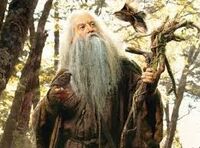
Radagast the Brown during the War of the Ring
In 2851 the White Council met once more and, after that, Saruman began to search the Gladden Fields for the One Ring. Radagast decided to aid his search with birds and beasts who acted as spies hoping that Saruman's actions would help watch and hinder Sauron. Radagast did this in good faith, knowing nothing of Saruman's real ambitions to keep the Ring for himself.[5]
By the time of the War of the Ring Radagast did not dwell any more in Rhosgobel. In summer 3018 Saruman told Radagast that he was willing to help Gandalf, and sent the Brown Wizard to seek him out at once. Radagast did not know much of Eriador but sought for the Shire, knowing that he would find Gandalf nearby.[3]
Indeed, on Midsummer's Day, Radagast was sitting on the side of the Greenway with his horse near Bree when Gandalf found him on his way to the village. Radagast warned Gandalf that the Nazgûl were abroad, disguised as riders in black, and that they were seeking news of the Shire. He also gave him Saruman's invitation and agreed to help Gandalf by getting beasts and birds to send news to Orthanc. With that he rode away back towards Mirkwood.[3]
By sending Gandalf to Orthanc, Radagast unwittingly had him captured. Saruman's message proved to be a trap for Gandalf who was imprisoned in Orthanc, but still he did not believe that Radagast was also a part of Saruman's plans. Indeed, it was thanks to Radagast that Gandalf was able to escape from the pinnacle of Orthanc upon the wings of Gwaihir.[3]
Radagast's actions during and after the rest of the War are not recorded. After the Council of Elrond, many scouts were sent out from Rivendell to many different locations. Some passed over the Misty Mountains and eventually came to Rhosgobel, but they found that Radagast was not there.[6] His fate after the War of the Ring is not known.[2]
Etymology
His original name, Aiwendil, meant "bird-friend" in Quenya; IPA: [aɪˈwendil]). It is comprised of the Quenya word aiwë ([small] "bird") and the ending -ndil ("friend").
According to the essay "The Istari" from the Unfinished Tales, Radagast means "tender of beasts" in Adûnaic, the language of Númenor. However, in a later note Tolkien said that the name is in the language of the Men of the Vales of Anduin, and that its meaning is not interpretable. The name Radagast may actually be Anglo-Saxon, and could have several interpretations, but, according to The Languages of Middle-earth, this name is derived from a Slavic pagan god. The name Radegast was a name for one of West Slavic lesser gods. He is a god of the Sun, war, fertility and harvest. He is also called Radigost, Radegast, Radhost, Radhošť, Redigast.[7]
The similarity to Old English rudugást meaning "red-brown spirit" has also been noted by fans.[8]
Character
Radagast is, of course, a worthy wizard, a master of shapes and changes of hue; and he has much lore of herbs and beasts, and birds are especially his friends.
—Gandalf[3]
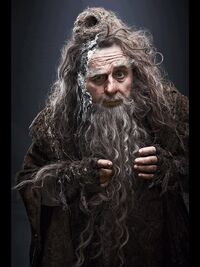
Radagast as seen in Peter Jackson's The Hobbit film trilogy
Tolkien's writing does not shed much light on Radagast's personality. In the books, little is known about Radagast apart from certain defining characteristics. Saruman was the chief of the Order of Wizards and Gandalf came next in the order; Radagast meanwhile held much less power and wisdom.[2]
As one of the Maiar of Yavanna, Radagast had a great interest in the kelvar and olvar of Middle-earth and was a friend to beasts and birds.[2][3] Gandalf, however, held greater respect from, and knowledge about, birds than Radagast.[9]
Radagast displayed some qualities of innocence and naivety, making him an ideal accomplice of Saruman's plans, seen in providing his services to help the White examine the Gladden Fields. Saruman in turn considered him simple (minded) and a fool and can be heard saying that he (Radagast) acted in a manner contrary to how an Istari should behave.
In the films Radagast has a eccentric personality, but is also selfless and brave, as when seen healing the hedgehog Sebastian and when holding off an Orc pack so Thorin & Company could go to Rivendell. He is also highly intelligent, being a Wizard, and has an adept understanding on how nature works, including performing healing spells and magical blasts.
Despite his somewhat childish ways, Radagast is also shown to be adept at combat, being able to hold his own against the resurrected Witch-king of Angmar. He is also brave, willing to help Gandalf any way he can – including rescuing him from Dol Guldur and even giving him his staff.
Radagast's fidgety and slightly hyperactive speech pattern is somewhat of a trademark of actor Sylvester McCoy, who has a history of playing eccentric and comedic characters.
Abilities
Radagast talking to a bird
In the books, during the Council of Elrond, Gandalf refers to Radagast as "master of shapes and changes of hue", but the meaning of this is open to question. He was wiser than any man in all things concerning herbs and animals. It is said that he spoke many languages of birds.
In the films, Radagast is portrayed as a strange, eccentric person who can communicate with animals and has a great knowledge of herbs and medicines, including being able to restore a recently deceased hedgehog to life. He is also shown to possess formidable combat abilities, such as being able to ward off an attack by the Witch-king of Angmar (or his summoned shade) while investigating Dol Guldur. His preferred form of transportation is a sled made of sticks and pulled by "Rhosgobel Rabbits". The sled is fast enough to outrun a pack of Gundabad Wargs, which were ridden by Orcs under command of Yazneg in the first Hobbit film.
Behind the scenes
It is unknown whether Radagast left Middle-earth. Tolkien writes that he forsook his mission as one of the Wizards by becoming too obsessed with animals and plants, so presumably failing, perhaps being disallowed to return to Valinor with honour. Tolkien also has written that he did not believe Radagast's failure was as great as Saruman's, and that he may eventually have been allowed (or chose) to return.[citation needed]
Other versions of the legendarium
From the first drafts of The Hobbit, Bladorthin identifies Radagast as a fellow wizard and as his 'cousin'. John D. Rateliff notes that, at this stage in the development of Tolkien's legendarium there was no reason why a wizard could not have a cousin. Rateliff also suggests that it is likely that Tolkien considered explaining Gandalf's absence (following the departure of Thorin and Company from Beorn's house) by saying that he went to visit Radagast (who lived close by) to plan the attack on the Necromancer.[10]
Early in the process of writing The Lord of the Rings, it is clear that Tolkien envisaged some role for Radagast in the tale.[11] He eventually decided that he would use Radagast as the means of getting Gandalf to Isengard.[12]
Initially Gandalf describes Radagast as his 'cousin',[12] as he did in The Hobbit, but in a subsequent draft he becomes his 'kinsman'.[13] In the final version Gandalf merely says that Radagast is 'one of my order'.[3]
Tolkien initially called him "Radagast the Grey", but in pencil he changed this to "Brown" and subsequently Saruman refers to him as "Radagast the Brown".[14]
When Tolkien finished writing the story up till Moria, he made notes on the future story development; therein he considered handing over Isengard to Radagast.[15]
Portrayal in adaptations
BBC Radio's The Lord of the Ring (1981)
Donald Gee provided the voice of Radagast. He is introduced much earlier than in the book because his meeting with Gandalf is given chronologically.
The Hobbit film trilogy
The character Radagast and virtually all references to him (with the exception of the presence of being Eagles directed by an unseen force) were not used in the film versions of The Lord of the Rings directed by Peter Jackson. The character is also absent from the 1978 animated movie of the same name.
Radagast does appear in Peter Jackson's The Hobbit trilogy, although none of the incidents involving Radagast in the films were ever mentioned in any of Tolkien's writings. In the book, Radagast is mentioned only once in passing, as Gandalf's cousin. In the films, he is portrayed by actor Sylvester McCoy of Doctor Who fame.
The Hobbit: An Unexpected Journey
Radagast is first mentioned in the film The Hobbit: An Unexpected Journey when Bilbo Baggins inquires of Gandalf whether there are any other wizards within Middle-earth. Gandalf responds that there are five wizards, of whom Radagast is one. Gandalf says that Radagast is a great wizard in his own particular way, enjoying the solitude of standing guard over the Greenwood forest and preferring the company of animals to that of Men.
Radagast is then seen investigating the Greenwood, noticing that much of the vegetation is beginning to decay and much of the animal life is sick or dying. Radagast brings one of them, a hedgehog he calls Sebastian, back to his woodland house at Rhosgobel where he is able to nurse the hedgehog back to health. Radagast comes to the realisation that a type of powerful witchcraft has caused the decay of the Greenwood and its transformation into what would now become known as Mirkwood. After Rhosgobel is swarmed by Giant Spiders, Radagast investigates and identifies the origin of the evil as the supposedly abandoned fortress of Dol Guldur.
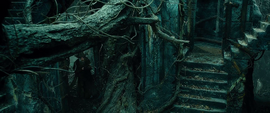
Radagast at Dol Guldur.
Radagast makes his way to Dol Guldur aboard a sled pulled by Rhosgobel rabbits. While Radagast is investigating Dol Guldur, he is attacked by the spirit of the Witch-king of Angmar. Radagast is able to ward off his attacks and forces the Witch-King to drop his Morgul-blade and retreat. Radagast takes the Morgul-blade, but before he leaves he sees a shadowy figure within the fortress, whom he believes to be the Necromancer.
He immediately goes on the search for Gandalf to inform him of the new found threat within Mirkwood and is able to locate him within the Trollshaws accompanying Thorin and Company. Radagast tells Gandalf of the threat the Necromancer is posing to Middle-Earth from within Dol Guldur and presents the Morgul-Blade as evidence. Shortly afterwards, the company is attacked by a battalion of Warg Riders led by Yazneg. Radagast volunteers to create a diversion with his sled of Rhosgobel rabbits, drawing the Warg Riders away from Thorin and company, who are able to reach the safety of the Hidden Valley of Rivendell. Radagast's rabbit sled's superiority in speed and maneuverability allows him to escape the Warg Riders before they are driven off by elven horsemen led by Elrond.
At the White Council meeting in Rivendell, Gandalf backs Radagast's claim that the Necromancer posed a serious threat to Middle-earth. But the head of the White Council, the white wizard Saruman, remains skeptical and claims there is no evidence to support such a theory despite Radagast's finding of the Morgul-blade. Saruman furthermore suggests that excessive consumption of mushrooms has addled Radagast's judgement and reduced his reliability.
The Hobbit: The Desolation of Smaug
In The Hobbit: The Desolation of Smaug, Radagast (who was presumably instructed by Galadriel) meets Gandalf inside the High Fells of Rhudaur and they find the tombs (or cells) of the Nazgûl broken into by 'dark spells'.

Radagast appears in the High Fells to aid Gandalf in investigating the Nazgûl tombs
Radagast became skeptical of Gandalf's beliefs that the Necromancer summoned the Nazgûl to Dol Guldur, believing that no human sorcerer could accomplish this. However, Gandalf reminded him that the Nazgûl only answer to their one true master, Sauron, whom he suspects is the true identity of the Necromancer. Realizing that Sauron plans on attacking the Lonely Mountain, Gandalf attempts to leave to rejoin Thorin and Company, but Radagast insists that they investigate Dol Guldur themselves. Upon arriving at the seemingly abandoned fortress, Gandalf guessed that a spell of concealment had been erected over the place, suspecting that their enemy has not regained his full strength. Gandalf sends Radagast to take a message to Lady Galadriel while Gandalf continues his own investigation of the 'abandoned' fortress.
The Hobbit: The Battle of the Five Armies
In the final installment of the trilogy, Radagast is seen chanting an incantation, seemingly a telepathic communication to support Gandalf as he attempts to break free from his cage. Later, he arrives at the Battle of Dol Guldur where he takes Gandalf to his sled, by the order of Galadriel. Radagast provides Gandalf a horse to ride to Erebor and his Wizard Staff to replace his old one. Gandalf tells Radagast to summon every bird and beast to join in the battle for the Lonely Mountain. Radagast leads a charge of the Great Eagles at the end of the battle to assist the Dwarves, Men, and Elves. He rides one of the eagles (possibly Gwaihir) along with Beorn.
Video games
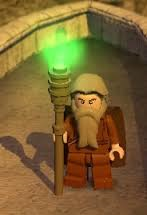
Radagast as a playable character in LEGO: The Lord of the Rings
- Radagast also appears in the trading card game affiliated with Jackson's The Lord of the Rings trilogy.
- Radagast appears in The Lord of the Rings Online, where he dwells in the city of Ost Guruth. The player aids Radagast through a quest series in the Lone-Lands, ending in a quest that sees Radagast and the player battle the Gaunt-Lord Ivar. Radagast beats Ivar and drives him away from the Lone-Lands. After Ivar is defeated, Radagast relocates to the tower of Barad Dhorn in Agamaur.
- Radagast appears in The Lord of the Rings: War in the North, where he flees from his home in Rhosgobel during the War of the Ring to one of his hideaways in Mirkwood. There Radagast is captured by the spider Saenathra, at the behest of Agandaûr. Radagast is later freed by Eradan, Farin and Andriel, who kill Saenathra. Radagast then tells the trio of where to locate the dragon, Úrgost, further advancing their quest. He is voiced by Phil Proctor.
- He appears in the game LEGO The Lord of the Rings as a playable character and can be purchased near Bree, however he does tend to wander and is not always in a set location. His equipment includes only a staff which is unique to this character.
- Radagast appears also in LEGO The Hobbit: The Video Game as a playable character. Radagast has the ability to heal sick creatures and to destroy blue Lego objects. For cooperative play purposes he joins Gandalf in investigating Dol Guldur.
- Radagast, based on Peter Jackson's The Hobbit Strategy Battle Game, is a hero figurine in two different versions: the standard model "Radagast the Brown with Sebastian", and a limited model sold with the box The Hobbit: Escape from Goblin Town.
Toys
Radagast is exclusive in LEGO to one set: Dol Guldur Battle. The set includes Radagast and his fellow wizard, Gandalf the Grey, and Azog and the Necromancer and two Gundabad Orcs.
Voice dubbing actors
| Foreign Language | Voice dubbing artist |
|---|---|
| Czech | Václav Knop |
| FrenchRadagast in LEGO Hobbit Video game (France) | Gabriel Le Doze |
| German | Erich Ludwig |
| Hungarian | Gábor Harsányi |
| Italian (Italy) | Bruno Alessandro |
| Polish | Wiesław Komasa |
| Portuguese (Brazil) (Television/DVD) | Mário Monjardim |
| Slovak | Boris Farkaš |
| Spanish (Latin America) | Eduardo Tejedo |
| Spanish (Spain) | Juan Fernández (AUJ) / Enric Isasi-Isasmendi (DOS) |
Gallery
 |
 |
 |
 |
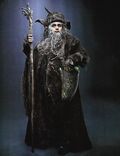 |
 |
 |
 |
 |
 |
 |
 |
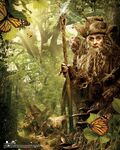 |
 |
 |
 |
 |
 |
 |
 |
 |
 |
Translations
| Foreign Language | Translated name |
| Amharic | ራዳጋስት |
| Arabic | راداغاست |
| Armenian | Րադագաստ |
| Belarusian Cyrillic | Радагасту |
| Bengali | ড়াদাগাস্ত্ |
| Bulgarian Cyrillic | Радагаст |
| Catalan | Ràdagast |
| Chinese (Hong Kong) | 瑞達加斯特 |
| Georgian | რადაგასტი |
| Greek | Ραδαγαστ |
| Gujarati | રદગસ્ત્ |
| Hebrew | רדגסט (Radagast)
אייוונדיל (Aiwendil) |
| Hindi | रैदागैस्ट |
| Icelandic | Ráðagestur |
| Japanese | ラダガスト |
| Kannada | ರಾಡಾಗ್ಯಾಸ್ಟ್ |
| Kazakh | Радагаст (Cyrillic) Radagast (Latin) |
| Korean | 라다가스트 |
| Kyrgyz Cyrillic | Радагаст |
| Macedonian Cyrillic | Радагаст |
| Marathi | रादागास्ट |
| Mongolian Cyrillic | Радагаст |
| Nepalese | ड़दगस्त् |
| Pashto | راداګاست |
| Persian | راداگاست |
| Russian | Радагаст |
| Sanskrit | रदगस्त् |
| Sinhalese | රදගස්ත් |
| Serbian | Радагаст (Cyrillic) Radagast (Latin) |
| Tajik Cyrillic | Радагаст |
| Tamil | ரடகஸ்தி |
| Thai | ราดากัสต์ |
| Ukrainian Cyrillic | Радаґаст |
| Urdu | راداگاست |
| Uzbek | Радагаст (Cyrillic) Radagast (Latin) |
| Yiddish | ראַדאַגאַסט |
References
- ↑ The Silmarillion, "Valaquenta: Account of the Valar and Maiar According to the Lore of the Eldar"
- ↑ 2.0 2.1 2.2 2.3 2.4 Unfinished Tales, Part Four: II: "The Istari"
- ↑ 3.0 3.1 3.2 3.3 3.4 3.5 3.6 3.7 The Lord of the Rings, The Fellowship of the Ring, Book Two, Chapter II: "Council of Elrond"
- ↑ The Hobbit, Chapter VII: "Queer Lodgings"
- ↑ The Lord of the Rings, Appendix B, "The Third Age"
- ↑ The Lord of the Rings, The Fellowship of the Ring, Book Two, Chapter III: "The Ring Goes South"
- ↑ Slavic languages
- ↑ "Radagast", Encyclopedia of Arda
- ↑ The Lord of the Rings: A Reader's Companion, p. 245V
- ↑ The History of The Hobbit, Mr. Baggins, The Second Phase, "Medwed", "(vi) Radagast"
- ↑ The Return of the Shadow, "The Third Phase: New Uncertainties and New Projections", p. 379; J.R.R. Tolkien, Christopher Tolkien (ed.), The Return of the Shadow, "The Story Continued: XXIII. In the House of Elrond", p. 397
- ↑ 12.0 12.1 The Treason of Isengard, "The Council of Elrond (1)", pp. 130-140 Cite error: Invalid
<ref>tag; name "TI" defined multiple times with different content - ↑ The Treason of Isengard, "The Council of Elrond (2)", p. 149
- ↑ The Treason of Isengard, "The Council of Elrond (1)", pp. 130-140
- ↑ The Treason of Isengard, "The Story Foreseen from Moria", p. 212
